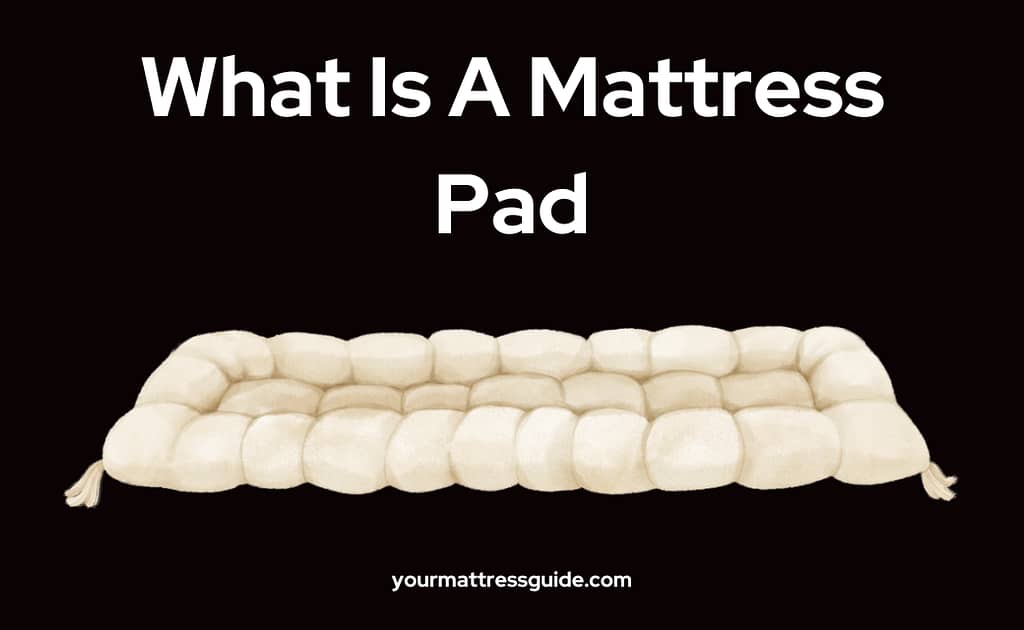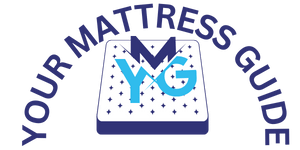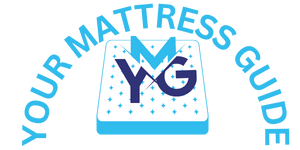Getting confused about what is a mattress pad. “Mattress pad,” “mattress protector,” and “mattress topper” are phrases that customers frequently mix up. Although these bedding products have various uses, they have certain similarities. You may need a mattress topper instead of a pad, or vice versa.
Now tell me what a mattress pad is and why you should use one. What distinguishes it from other bedding accessories and a mattress topper? We’ll address your concerns and make things clear today.

What Is A Mattress Pad?
Mattress pads give your mattress an extra layer of luxury and comfort. You can usually find them linked to your fitted sheets or with straps that secure them to the mattress in the corner.
Adding layer of comfort to the surface of your mattress is the main objective of the mattress pad.
The little things are what count. For example, mattress pads can provide your bed an additional layer of coziness. They have a thickness range of 1 to 1.5 inches and are frequently quilted.
It’s not as easy as getting a decent night’s sleep seems. Your mattress can feel too soft, your pillows less firm than they used, or your linens too rigid.
Considering these things, it’s sensible to get the best bedding you can afford. This does not, however, imply that you should splurge on pricey cushions or brand-new linens. All you have to do is select the appropriate items.
Uses Of Mattress Pads:
For the following reasons, a mattress pad is required:
1. The mattress is firm; to make it softer, consider adding a cushion.
2. For health reasons, you require more comfort and support.
3. Although it is resistant and safeguards your current bed, you don’t want a mattress protector.
4. You prefer a cozy mattress pad over a noisy mattress protector.
5. The bed is getting old and is uncomfortable, but you don’t have the money to replace it yet.
Do You Need Mattress Pads?
This bedding piece is not necessary. Typically, you would use it to increase the comfort level of your mattress. You don’t need a mattress pad if your mattress feels perfect.
If that’s what you’re after, go with a mattress protector. Notably, if necessary, you can use a mattress protector in addition to a pad.
Although most types are not waterproof, mattress pads can shield your mattress from abrasions and deterioration. As a result, they will not prevent spills, perspiration, and urine stains.
Difference Between Mattress Pads Vs. Mattress Toppers
Your bed can be made more comfortable with either mattress pads or toppers. To a certain extent, they may shield your mattress even if they are typically not waterproof.
Their structure is where the two diverge most from one another.
Conventional mattress toppers are thicker than mattress pads, often thinner and lighter.
The latter is usually composed of memory, poly, or latex foam for added comfort. It can significantly impact the dynamic of mattress comfort because it resembles a thicker mattress pad in certain aspects.
Let’s examine some further points where mattress pads and toppers differ and are similar:
- These are mattress-top accessories that are available in a variety of colors and patterns.
- Toppers feature multiple thick layers of foam or padding, while mattress pads are usually pleated and have a single, padded layer.
- Compared to mattress pads, mattress toppers are heavier and more challenging to clean.
- Neither product provides stain or spill resistance. Their function is to give your mattress an additional layer of cushioning.
- Generally, mattress toppers are more costly than mattress pads but less expensive than a brand-new mattress.
You can adjust a mattress’ hardness to suit your needs with mattress toppers. Regarding controlling your body temperature, these products outperform mattress pads.
According to one study, men who utilized a high-rebound mattress topper slept better. Furthermore, they were prevented from tossing and turning in bed by both low- and high-rebound toppers. Usually, mattress pads are too thin to offer these advantages.
Depending on your needs, you may use a mattress pad, mattress topper, or both. It all boils down to your desired comfort level and how your current mattress feels. Curious about enhancing your sleep experience? Delve into our guide on how long mattresses are good for to ensure you make the most out of your investment.
What Is A Mattress Topper?
As previously said, mattress toppers are improved pads that are thicker. They are specifically made to improve the comfort and luxury of your current mattress.
Mattress toppers are positioned on top of the mattress, just as mattress pads. They may be sent with or without straps to help you fasten them to your mattress more firmly. Mattress toppers can be thick and filled with a variety of materials.
Toppers are easily found when the following resources are used:
- Memory Foam
- Down
- Gel Memory Foam
- Cotton
- Foam
- Polyester Cluster Puffs or Fiberfill
- Latex Rubber
Mattress Pad & Mattress Topper Materials
Regarding a mattress pad versus a topper, both mattress toppers plus pads can be integrated with waterproofing technology, preventing dust mites and allergies from seeping into the mattress.
Others are constructed with materials like cooling gel foam that create a cozy sleeping environment.
Most of the time, a natural mattress topper and your natural mattress pad are identical.
They are designed to enhance general sleep quality, give any bed an opulent sense, and be environmentally responsible. Feathers, wool, latex, and other materials can be used to make them.
The following materials are essential to consider when selecting a mattress pad or topper, whether they are natural or synthetic:
Natural Latex Pads:
Natural latex, as we all know, is made from rubber trees and, with the proper maintenance, can last for more than ten years. This material is hugely hypoallergenic and will never draw mold or dust mites.
The latex core of natural latex pads, also known as toppers, is covered with cotton or wool. These can be pricey, but given the comfort and advantages they provide in the long run, it is an investment that everyone should make.
Wool Pads:
Due to their softness, wool mattress pads are in high demand. It feels like you’re dozing off on a cloud of velvet. In addition to being allergy-resistant, organic wool may keep dust mites and mildew off your bedding.
In addition, it acts as a natural insulator, keeping you warm during the winter. Your wool will inevitably mat down and grow hard over time, but you can use a steamer to restore its softness.
Featherbed Mattress Pads:
Because featherbeds are plentiful and quite soft, some people place them on their mattresses. This mattress pad can be filled with either natural or synthetic down. In really cold conditions, down can be warm; in warm weather, it can sleep cool. The fitted sheets on the bed keep the featherbed in place when placed on the mattress.
Cotton Mattress Pads:
As the name implies, a cotton mattress pad is thin and has a quilted surface. These are frequently referred to as “mattress covers” and serve to protect the mattress. These are usually machine washable and fastened to the top of the mattress with elastic bands in the corner. It gives your current mattress more smoothness and comfort.

What Is A Mattress Protector?
As was previously said, mattress pads or toppers do not protect against spills and stains. If you require that, a waterproof mattress protector is the best option.
A fitted sheet is what a mattress protector looks like. Depending on its composition, it may offer protection against germs, mold, dust mites, and allergies.
For people who have children or pets, are concerned about bed bugs, or just want to maintain the condition of their mattresses, it can be a useful option.
If you use one, the mattress protector can be placed on top of a mattress pad or topper. But mattress pads should be washed every few months; therefore, you could want to put them directly underneath the sheets for more straightforward access.
Types Of Mattress Pads
Although some mattress pads are made to preserve your mattress, others are made to improve comfort while you sleep. These models could be composed of unique textiles that wick moisture or might be waterproof. There are also heated mattress pads available.
After attempting to ascertain your expectations, establish a spending limit. Examine the many models and kinds of materials.
You have a choice among the following options, depending on what you require:
- Elasticized sides on fitted pads
- For a better fit, anchor mattress pads have multiple thin straps; some variants are reversible.
- Simply place flat mattress pads—which resemble thicker blankets—on top of your mattress, under the sheets.
- Mattress pads featuring zippers: these types fully enclose the mattress, safeguarding its sides, top, and bottom.
- Mattress pads with heating elements
Various materials consisting of these models include:
- Blends of cotton
- Poly-cotton
- Synthetic materials (polyester, nylon, or rayon)
- Feathers Disappear Microfiber
For example, wool, bamboo, and microfiber can retain heat and be an excellent option in the chilly winter. Even better is wool, but it costs a lot of money. Wondering about the perfect sleep setup for outdoor adventures? Explore recommendations on what size tent for a queen air mattress to make your camping experience comfortable and enjoyable.
How To Choose A Mattress Pad?
Reading or watching TV in bed can be more comfortable, and your sleep can be enhanced with a high-quality mattress pad. You get exactly what you pay for with most things, too.
Think about your budget first. Second, consider what you need for your health. For instance, selecting a cotton mattress pad makes sense if you have an allergy to polyester or other synthetic fibers.
Before selecting a mattress pad, compare the various varieties available. Square jacquard quilting, hypoallergenic polyester fill, deep pocket designs, and other premium features are standard on high-end versions.
When looking for a mattress pad, bear the following points in mind:
- Choose the appropriate size for your replacement mattress pad.
- These bedding options are available in Twin and Twin XL, Queen, King, and California King sizes.
- Make sure the pocket depth fits your mattress by checking it.
- Think about investing in a machine-washable model.
- Mattress pads seldom have a thickness of more than 1.5′′. Select a mattress topper in place of a thicker model if necessary.
- Waterproof mattress pads are rare. For this functionality, you will typically have to pay more. A waterproof cover would cost less.
- If you have allergies or textile contact dermatitis, use a hypoallergenic model.
- Invest in a model with a larger fill count if you want more softness.
Wrapping It Up!
What Is A Mattress Pad can intrigue newbies stepping into the bedding department. Moreover, we hope this article answers your questions in depth and precisely.
Although not necessary, a mattress pad could be helpful too. Although not as much as a mattress protector, this product can give your mattress a little more cushion and protection against dust mites, bed bugs, and bacteria.
You can also check out Are Latex Mattress Toppers Toxic? For more information.
FAQs
What Is A Mattress Pad? Do you Need Both A Mattress Pad & Topper?
Most likely not. One of these is sufficient as they perform almost identically. It could be time to get a new mattress if you require both to alter the feel of your current one significantly.
Can you sleep on a mattress pad?
Ultimately, sleeping on a topper alone for a short or long duration depends on a person’s preferred resting temperature and unique body requirements. Consult your healthcare practitioner if you’re unsure if sleeping on a mattress topper alone is the best option for your physical health.
Do mattress pads go under sheets?
The order of your layers should be as follows: fitted sheet, flat sheet, mattress protector (optional), mattress topper, and mattress.


